Is this the best starting rotation in Astros franchise history?

With the addition of Zack Greinke, the Astros boast one of the most formidable rotations in franchise history.
The Astros already had one of the best starting rotations in the game with Justin Verlander, Gerrit Cole and Wade Miley toeing the rubber three out of every five days. Then they added a future Hall-of-Famer in Greinke.
The team now boasts the game’s best starting staff and are World Series favorites. Anything less than a second championship would be a bust. With all these expectations, this roster has to be the best Astros team in club history.
But is this the best starting rotation in club history? The Astros have been fortunate to have some good groups over the years. How does this one stack up with the rest?
Also, with all due respect to the ridiculous numbers the Astros’ 1968 rotation put up, I’ve decided not to include it since that was the Year of the Pitcher in which pretty much everyone pitched well. It wouldn’t be a good comparison to make, despite the presence of two excellent pitchers in Larry Dierker and Don Wilson.
This Year’s Group
The de facto ace is Verlander, and he’s in the midst of another excellent season. As of this writing, he has an MLB-leading 14 wins and AL-leading 2.73 ERA. He also leads the majors in WHIP (0.811) and hits allowed per nine innings (5.5). He also leads the league in ERA+ and strikeout-to-walk ratio.
Cole leads the majors this season with 216 strikeouts and an average of more than 13 strikeouts per nine innings. He’s also notched 13 wins and a 2.87 ERA. He garnered his second top five Cy Young finish in 2018 and looks headed for yet another one this year.
Greinke is the new addition, but he stands toe to toe with the best of them. He’s 10-4 with a 2.90 ERA on the season and is up to 197 wins for his career. He’s posting excellent numbers in the WHIP (0.945) and strikeout-to-walk ratio (6.43) categories while giving up fewer homers than in previous seasons, despite the league’s juiced nature.
Not to be outdone, Miley is having a great season in his own right. Nine wins and a 3.06 ERA from your fourth starter is something every team would gladly take. This top four would stand up against any other staff the team will face this season.
Finally, Brad Peacock has performed admirably, posing a 4.13 ERA in 15 starts and two relief appearances. If he can return to form once he’s off the IL, the rotation will be strong all the way around.
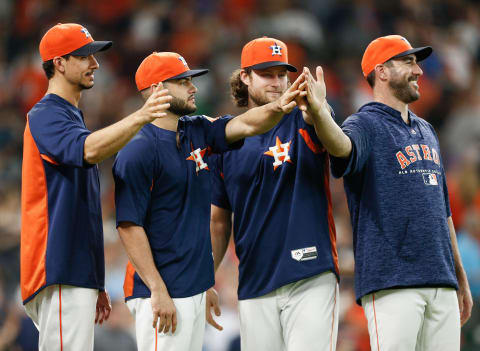
2018: Verlander, Cole, Charlie Morton, Dallas Keuchel, Lance McCullers Jr.
As good as this season’s group is, last year’s rotation was actually deeper. All five regular starters ended up with double-digit win totals and ERAs under 4.00. It was a virtual Murderer’s Row.
Verlander led the way with 16 wins and a 2.52 ERA, leading the league with 290 strikeouts and leading the majors with a 0.902 WHIP. He ended up finishing second in the Cy Young voting, losing to Tampa’s Blake Snell.
Cole finished fifth in the voting on the strength of 15 wins and a 2.88 ERA with 276 strikeouts. He led the majors with 12.4 strikeouts per nine innings and served as a co-ace along with a future Hall-of-Famer. Not too shabby.
Morton was the third Astros pitcher to strike out 200 batters last season, also notching 15 wins to go along with a 3.13 ERA. He led the majors in winning percentage and earned his first All-Star selection.
Keuchel posted a 12-11 record with a 3.74 ERA, winning his fourth Gold Glove award and leading the majors in total batters faced. Along with Verlander and Cole, he was the third Astros pitcher to throw 200 innings that season.
Finally, McCullers made 22 starts and three relief appearances, compiling a 10-6 record and 3.86 ERA in 128.1 innings. He solidified the fifth starter spot for much of the season, giving the Astros an incredibly deep rotation.
In comparing the two staffs, Morton and Keuchel have essentially been replaced by Greinke and Miley, respectively. Greinke is having a better season ERA-wise than Morton did and is generally a more well-regarded pitcher overall. Keuchel has more accolades than Miley, but Miley is having the better season.
The fifth spot would be the deciding factor. If Peacock can return to match or improve upon the 4.13 ERA he’s posted this season, that could tip the scales in 2019’s favor. Otherwise, 2018 still has a claim to being the best rotation in Astros history.
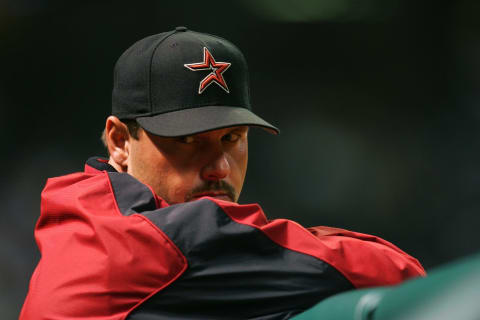
2005: Roger Clemens, Andy Pettitte, Roy Oswalt, Brandon Backe, Wandy Rodriguez
The Astros reached their first World Series in 2005 after coming oh so close the year before. They were greatly buoyed by a dominant trio of starters in Clemens, Pettitte and Oswalt.
Clemens led the majors in ERA (1.87), ERA+ (226) and hits per nine (6.4). He only finished third in the Cy Young voting thanks to a pedestrian 13-8 record owing to poor run support. Still, he was arguably the game’s best pitcher that year at age 42.
The left-handed Pettitte posted a career-best 2.39 ERA in 2005 to go along with 17 wins and a top-five Cy Young finish. He also largely avoided allowing hard contact, giving up just 7.6 hits per nine innings and 0.7 home runs per nine to go with a career-best 1.7 walks per nine.
Oswalt notched his second straight 20-win season, tossing 241.2 innings of 2.94 ERA ball. He threw four complete games and faced more than 1,000 batters, earning a fourth place finish in the Cy Young voting.
Backe finished with a career-best 10 wins to go with a 4.76 ERA in 25 starts and one relief appearance, spanning 149.1 innings. Most memorable would be his start in Game Four of the World Series in which he simply mowed down White Sox hitters but took a no-decision in the loss.
Rodriguez would go on to have some successful seasons with the Astros, but his rookie season was not one of them. He made 22 starts and three relief appearances, posting a 10-10 record and 5.53 ERA.
In comparing this to 2019’s staff, it’s tough to decide which Big Three is better. Both trios were as good a group as there is in the game. The difference is depth. While the 2005 team’s No. 4 and 5 starters were average or worse, 2019’s group has Miley and Peacock. This gives the current rotation the edge.
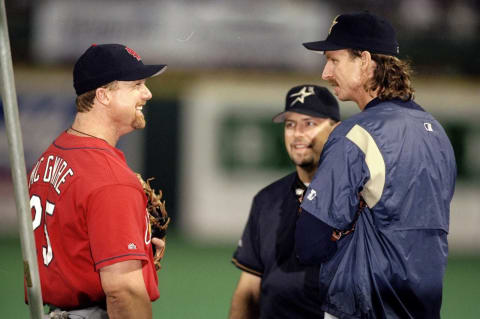
1998: Randy Johnson, Mike Hampton, Shane Reynolds, Jose Lima, Sean Bergman
1998 was the year the Astros really went for it, shipping off a package of prospects for The Big Unit. Johnson was absolutely brilliant in his brief run with Houston, posting a 10-1 record and microscopic 1.28 ERA in the regular season. He also pitched to a 1.93 ERA in two postseason starts, though he would lose them both.
Hampton’s 1999 season was better, but he still put up a 3.36 ERA in ’98 with 11 wins over 211.2 innings. He was an excellent No. 2 starter to put behind Johnson and tossed six innings of one-run ball in his only playoff start that year.
Reynolds had a nice run with the Astros for a few years, and this was one of his better seasons. He won a career-best 19 games with a 3.51 ERA, striking out 209 batters. For some odd reason, he did not get a single Cy Young vote that year.
It’s Lima Time! The dearly departed Lima mostly pitched poorly throughout his career, but had a good two-season run in ’98 and ’99. In this season, he won 16 games with a 3.70 ERA, leading the league in strikeout-to-walk ratio while throwing 233.1 innings.
This was by far Bergman’s best season, winning 12 games with a 3.72 ERA. It was also his only full season with the Astros, as he bounced around and finished with a career ERA north of 5.00.
While one could argue that Johnson is superior to any pitcher the Astros currently have in their rotation, the same cannot be said about the rest. Hampton was an excellent pitcher for a long time but didn’t quite break through to being a true ace. The remaining three pitchers were solid in this particular season, but this 2019 team has three legitimate aces plus Miley. This is an easy call.
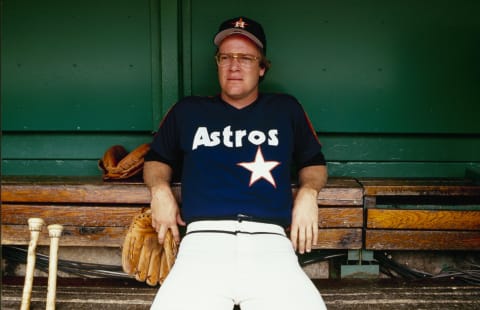
1986: Mike Scott, Nolan Ryan, Jim Deshaies, Bob Knepper
This was Scott’s Cy Young season after having an 18-win breakout the year before at age 30. He led the majors in ERA (2.22), innings pitched (275.1), strikeouts (306), WHIP (0.923) and strikeout-to-walk ratio (4.25), among others. He also cracked the Top 10 of the MVP voting and threw a no-hitter to clinch the division title.
Ryan had some better seasons in Houston than this, but he still pitched to a 3.34 ERA in 30 starts at age 39. He was effective, and let’s be honest here — any season from Ryan is one that’ll boost a pitching staff.
1986 was Deshaies’ breakout year at age 26 as he finished seventh in the Rookie of the Year voting (one spot behind some guy named Barry Bonds). He posted 26 starts of 3.25 ERA ball, winning 12 games and beginning a nice stretch of reliable pitching from the southpaw.
The left-handed Knepper had some nice years for the Astros in the 1980s, and this was one of them. He won a career-best 17 games with a 3.14 ERA, tossing 258 innings despite striking out only five batters per nine.
These four were the only players to make double-digit starts for the Astros that year. Putting them against the 2019 team’s top four, it’s an interesting comparison. Scott and Ryan were both bona fide aces, while Deshaies and Knepper were effective mid-rotation guys. The current team has three aces plus one effective mid-rotation guy. 2019 wins again.
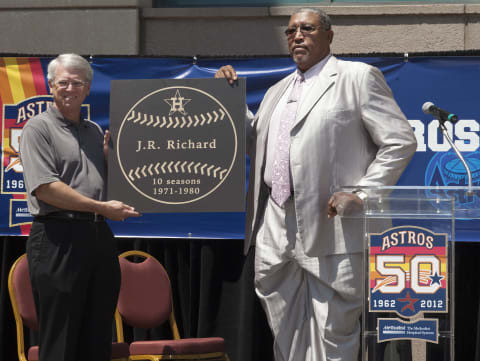
1980: J.R. Richard, Nolan Ryan, Joe Niekro, Ken Forsch, Vern Ruhle
What a Big Three this was, but it was tragically short-lived. Richard was in his prime, coming off a 1979 season in which he led the majors in ERA and strikeouts, and he’d won at least 18 games in four straight seasons. The free agency signing of Ryan gave the Astros an incredibly intimidating 1-2 punch.
Richard had a 1.90 ERA in 17 starts in 1980, earning his first All-Star nod. Then he suffered a stroke that ended his season and his career. At his peak, there was no one hitters were more scared of than Richard.
More from Climbing Tal's Hill
- Just how much better is the Houston Astros playoff rotation than the rest?
- Houston Astros: A Lineup Change to Spark Offense
- Astros prospect Hunter Brown throws 6 shutout innings in debut
- Always faithful Astros World Series champion Josh Reddick defends the title
- Michael Conforto declines Astros’ 2-year, $30 million offer
Ryan went 11-10 in his debut season with the Astros, throwing 233.2 innings. As is the case with 1986, he had better seasons in Houston, but his presence in the rotation is enough.
Niekro had his best years with the Astros, with 1980 being one of them. The knuckleballer won 20 games with a 3.55 ERA, finishing fourth in the Cy Young voting. He would win 221 games in a 22-year career.
Forsch was in his final season with the Astros in ’80, having spent a good portion of his time in Houston as a very effective reliever. He made 32 starts that year, posting a record of 12-13 despite a solid 3.20 ERA over 222.1 innings.
The late right-hander Ruhle won a career-best 12 games in ’80 with a 2.37 ERA. He had a few good seasons for the Astros, but this was his most significant, as he made the most starts and threw the most innings of any season he had in Houston.
When it comes to a Big Three, this one matches up remarkably well with the current trio. Both consist of two flamethrowing strikeout machines (Verlander/Cole, Richard/Ryan) and one of the more crafty variety (Niekro, Greinke).
Astros option Straw, Urquidy, Abreu. dark. Next
Greinke is probably the superior pitcher to Niekro, and both Richard and Ryan had the tendency to walk quite a few batters. Still, the 1980 club had five quality starters, while this year’s club really only has four. There’s a case to be made that the 1980 group is still the best.